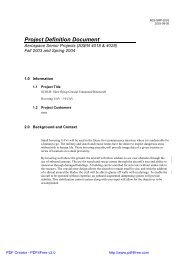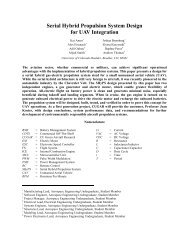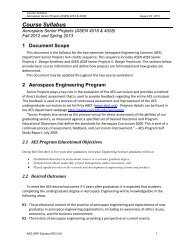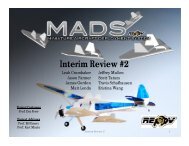PFR - Aerospace Engineering Sciences Senior Design Projects ...
PFR - Aerospace Engineering Sciences Senior Design Projects ...
PFR - Aerospace Engineering Sciences Senior Design Projects ...
Create successful ePaper yourself
Turn your PDF publications into a flip-book with our unique Google optimized e-Paper software.
Project Final Report – CUDBF April 30 th , 2009<br />
ASEN 4028: <strong>Aerospace</strong> <strong>Senior</strong> <strong>Projects</strong><br />
The first flight of the aerodynamic prototype was a success. The pilot reported that the aircraft<br />
was indeed stable, and the decision was made to remove the ballast to return the aircraft to its<br />
normal static margin of 5%. A long ground roll was noticed on takeoff. This was attributed to an<br />
analysis error made early on in the year. The relationship between the Cl in the takeoff distance<br />
equation and aircraft incidence angle was not recognized, which resulted in a lower aircraft Cl<br />
than predicted during initial analysis. To account for this lack of lift, an incidence angle of 5°<br />
was added in order to increase the takeoff C L to 0.6 in order to make the 100 ft takeoff<br />
requirement. More about this change can be found in section 8.1.3. Pictures from the first flight<br />
are shown in Figure 122.<br />
Figure 122: Pictures of Buff-2A flight test #1<br />
13.2.2.2 Flight Test #2 and #4<br />
The purpose of these flight tests were to gather more qualitative data on aircraft handling and to<br />
accustom the pilot to the aircraft before riskier tests were undertaken. Both of these flight tests<br />
had successful takeoffs and airborne maneuvering portions. However, both of these flight tests<br />
ended with the nose gear breaking on landing. The main reason for the nose gear failure was that<br />
the aircraft was designed to sustain normal main-gear-first landings of up to 4.0 g’s. However,<br />
the nose gear was not designed to sustain the loads encountered by fast nose-gear-first landings.<br />
The reason for the nose-gear-first landings was due to the pilot still getting accustomed to<br />
landing the aircraft. The Buff-2 Bomber was designed with a relatively small wing and high stall<br />
speed in order to reduce aircraft size, fit in the box, and reduces overall weight. However, these<br />
design decisions indicate that the aircraft must land at a relatively high speed (25 mph when<br />
empty) and the pilot needed some practice flying the aircraft in order to make purely main-gearfirst<br />
landings. The nose gear failures that occurred during these two flight tests led to a redesign<br />
of the nose gear shown in section 8.48. Pictures of the nose gear failure upon landing are shown<br />
in Figure 123.<br />
139
















